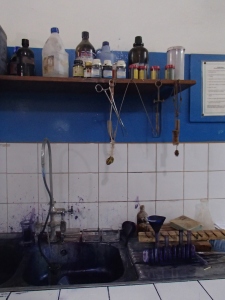Last year, the magnificent Emma walked 100km from London to Brighton in memory of her grandmother, and in support of Parkinson’s UK. She walked through the day and night, suffered horrendous blisters, still looked fabulous when she crossed the finishing line after 23 hours and 18 minutes, and raised a staggering £1727 for a cause close to her heart. I found this truly inspirational. This year, I raise my glass to you Emma, and announce that I’m taking on the challenge too. 100Km, day and night, from London (Richmond) to Brighton Racecourse, over the May bank holiday weekend (24th-25th May). I’ll be walking for established global clean water and improved sanitation charity, WaterAid.
On this very blog, I documented my summer 2013 in Ghana, researching the use of untreated wastewater in the capital city Accra. In Ghana, an estimated 4000 children die of diarrhoeal disease each year. All but perhaps the tiniest fraction of these could be prevented with the provision of clean water and improved sanitation facilities. Here’s an extract of an entry I wrote this summer, but never posted. The sense of injustice I felt… the words could never really convey.
I used to work at a crèche to earn money in the Summer holidays. There was a rigid routine, and I found it a little monotonous – help them to wash their hands, give them a snack, change their nappies (washing your hands before and after every child), supervise play, help them to wash their hands, wash your hands, give them lunch, change their nappies (washing your hands before and after every child), put them to bed, wake them up, change their nappies (wash your hands), wash their hands, give them a snack…. wash hands, nappies, wash hands, food, wash hands, nappies, wash hands, food, hands, nappies, hands … wash hands wash hands wash hands wash hands. My day was dominated by a constant search for flannels, filling buckets with warm soapy water, briskly rubbing sticky fingers. I washed my own hands seemingly continuously – sometimes more than 50 times a day. Even now, as a medical student, with the stages of the Ayeliffe hand-washing technique and the 5 points of patient contact at which it should be employed branded for all eternity in my sub-conscious, never has hand-washing been such a big part of my life as when I worked with all those little children. Its boring and time-consuming. And it saves lives.
Children die of diarrhoea, in large numbers. Children still die of diarrhoea in large numbers. Please just think about that for a moment. Let it really sink in. Diarrhoea, yes, diarrhoea, that cramping discomfort, those loose watery stools that most of us consider an occasional nuisance (even a fair trade-off for a dirty kebab or an exotic holiday perhaps) kills over seven hundred thousand children every year. I’m not talking about cholera, typhoid or something equally distant or tropical (although children do die of these too). The majority of diarrhoea deaths are due to the same old culprits, the common or garden viruses and bacteria send children and adults all over the world running for the toilet every day, which you’ve almost certainly been infected with and will be infected with again. Children are still dying of diarrhoea that is just diarrhoea. This is intolerable.
Diarrhoea is transmitted by the “faeco-oral” route; ingesting pathogens from someone else’s excrement; poo by mouth. We consider toilets and sewage management systems an inelegant and unspeakable given, but the truth is that 2.5 billion people globally do not have access to a safe, clean and private toilet. And globally, nearly 2000 children a day die because of it. Trapped in a viscious cycle, dirty water spreads diarrhoea, further contaminating the available water supplies, leading to further spread, more disease, more death.
For everyone forced to rely on unsafe drinking water, for anyone who lacks a toilet, and for all those who have been harmed by pathogens spread by poor sanitation practices – this one is for you. If you feel moved to donate to WaterAid in support of this wild endeavour it would mean the world to me, and you can do so over on my WaterAid fundraising page. And you are positively welcomed, encouraged – indeed begged – to read all about my training, my progress, my thoughts, and my little life, right here on Where’s Viv.

